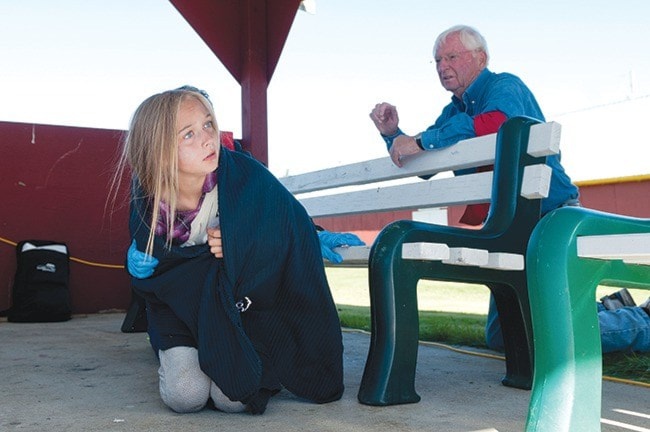With the low rumble of the earth shaking, the roar and crash of buildings toppling and the strident call of car alarms and shrieks for help, nearly 150 mid-Island residents were thrust into a nightmare emergency response Sunday at the Coombs Fairgrounds.
The catastrophic earthquake and resulting "injuries" were not real, but the lessons learned in the Regional District of Nanaimo's weekend-long disaster response training and simulation will help emergency response coordinators determine future policies and training procedures with groups of community volunteers, said Jani Drew, RDN's emergency coordinator.
"This is our third big (disaster response) workshop and our second simulation," said Drew. "And it's a total 180-degree change from how we ran the last one, all based on the feedback we got."
Unlike similar mock-disaster drills used to coordinate efforts of law enforcement, fire department and ambulance personnel, last weekend's Prepare to Survive training and drill in Coombs was held for civilian volunteers through the RDN's Neighbourhood Emergency Preparedness Program (NEPP).
These are the people, Drew and other trainers noted, who will likely be first on the scene locally if the professional responders are without access or are called to higher-priority areas.
Partnering with the municipalities of Parksville, Qualicum Beach and Lantzville, regional district personnel hosted training classes throughout Saturday, covering the basics of site assessment, search-and-rescue, power shut-off, communications, triage, evacuation and first aid.
The day was supported by representatives and display booths from BC Hydro, Fortis, St. John Ambulance, the Canadian Red Cross, Emergency Social Services of Gabriola Island and a number of private businesses specializing in safety and first aid equipment and training.
After a review Sunday morning, the simulated disaster began with sound effects piped in through speakers placed about the fairgrounds. Actors in bloody makeup were scattered throughout the buildings, representing injured victims in the homes and businesses of a neighbourhood.
Volunteers from Coombs-Hilliers Fire Department provided smoke machines to add an air of realism to the event and also coordinated fire-suppression training, but did not participate in the response as the civilian responders were left to their own devices.
“The people had to go and use their rapid damage-assessment skills to see if it was going to be safe for the rescuers to go in (buildings),” said Drew. “And then they brought people out to safety, to the first aid station. Each of these groups had to practise their particular response skill, and in doing so learned so much.”
Another group of volunteers was stationed in the fairgrounds bleachers as observers. Their input was combined with that of the responders and even the victims in a debriefing following the simulation. That debrief serves as the core of the exercise, Drew said.
“We want to know what it felt like to do these response roles,” she said. “What do you think we could do to make it go smoother or better next time? Everyone has a different perspective. What we do in the debrief is we ask people to tell us, what are the best things that happened? What are the signposts for next time, things that we can improve upon or what can we do differently?”
Shortly after the initial “earthquake” subsided, the rescuers streamed from the main hall to gather at their respective base stations. With screams of “victims” coming from a nearby building, two women on the first aid team grabbed a stretcher and carried it toward the entrance. A third volunteer, with the assessment team, warned them it was not safe to enter the building, pointing to a placard indicating the smell of gas.
Several times the response was interrupted by “aftershocks”, signified by the earthquake sound rumbling through the speakers as responders ducked under furniture and other structures or draped their bodies over victims.
“We teach people to look after themselves first,” said Drew. “You can’t help others unless you have taken care of yourself first,” said Drew.
